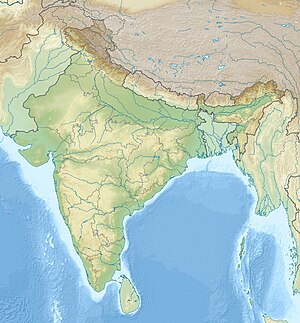Phawngpui National Park
| Phawngpui National Park | |
|---|---|
 | |
| Location | Mizoram, India |
| Nearest city | Aizawl |
| Coordinates | 22°40′N 93°03′E / 22.667°N 93.050°E |
| Area | 50 square kilometres (19 sq mi) |
| Established | 1992 |
| Visitors | 469 (in 2012-2013) |
| Governing body | Department of Environment and Forests, Government of Mizoram |
Phawngpui National Park or Phawngpui Blue Mountain National Park is one of the two national parks of India in Mizoram, the other and the larger being Murlen National Park. It is about 300 km from the main city Aizawl, located in the Lawngtlai district, towards the southeast of Mizoram and relatively close to Burma. It bears the name of the mountain Phawngpui, often called the Blue Mountain of Mizoram, which is the highest mountain peak in the state, reaching 2,157 m asl.[1] The national park covers the entire mountain along with the surrounding reserve forest.[2]
Geography
The mountain area of Phawngpui is at most times covered by a thin stretch of clouds, which makes it blue in appearance from a distance, hence the name Blue Mountain. The temperature therefore is mild throughout the year ranging from 11-29°C, with an average rainfall of 3,000 cm.[3] It overlooks the major river Chhimtuipui flowing towards Burma. The edges of the mountains are all very steep and mostly of sharp precipices, and the most spectacular is a semi-circular beautiful cliff on the western side called Thlazuang Khâm, which has a blunt and deep fall.[4] The mountain ridge runs in a north-south direction covering about 10 km. The closest human settlement is Thaltlang village at the base and periphery of the park.[5]
Flora and fauna
The Phawngpui National Park provides habitat for a range of birds including the rare Blyth's tragopan, falcon, sunbirds, dark-rumped swift, and Mrs. Hume's pheasant, which is the Mizoram state bird, and also rare animals like the mountain goat, slow loris, tiger, leopard, leopard cat, serow, goral, Asiatic black bear, stump-tailed macaque and capped langur.[6] In 2000, rare bird species were recorded such as mountain bamboo partridge, oriental pied hornbill, purple cochoa, striped laughingthrush, grey sibia, black eagle and large-billed crow.[7] The clouded leopard (Neofelis nebulosa) was spotted and documented for the first time in 1997.[8] The landscape is the natural habitat of various grasses (in fact is the origin of the name, phawng in Lai dialect means "meadow", and -pui is the suffix for "great"). The steep slopes are covered by orchids and rhododendrons, with areas of bamboos.[5]
Tourism
The Government of Mizoram allows ecofriendly visit to the national park only during the dry season, i.e. permit is open for 6 months from November to the end of April. The rest of the season is left for natural development and rejuvenation. During the last opening season, there were 569 visitors including 52 foreigners.[9]
See also
References
- ^ "Phawngpui". mizotourism.nic.in. MizoTourism. Archived from the original on 3 March 2013. Retrieved 26 June 2013.
- ^ Bhatt SC,Bhragava GK (eds) (2006). Land and People of Indian States and Union Territories: Mizoram (Volume 19). Delhi: Kalpaz Publications. p. 153. ISBN 9788178353753.
{{cite book}}:|author=has generic name (help) - ^ World Wildlife Adventures. "Phawngpui Blue Mountain National Park, Mizoram". world-wildlife-adventures.com. Archived from the original on 27 March 2013. Retrieved 26 June 2013.
- ^ Pachuau, Rintluanga (2009). Mizoram: A Study in Comprehensive Geography. Northern Book Center. p. 95. ISBN 978-8172112646.
- ^ a b Department of Tourism (2012). "Mizoram Tourism - Phawngpui". The Department of Tourism, Government of Mizoram. Retrieved 26 June 2013.
- ^ Property Direction (18 April 2013). "Phawngpui Blue Mountain National Park, Mizoram". propertydirection.com. Retrieved 26 June 2013.
- ^ Choudhury A (2006). "Notable bird records from Mizoram in north-east India" (PDF). Forktail. 22: 152–155.
- ^ Ghose, D. (2002). "First sighting of the clouded leopard Neofelis nebulosa from the Blue Mountain National Park, Mizoram, India" (PDF). Current Science. 83 (1): 20–21.
- ^ Editor (15 May 2013). "Thla 6 chhungin Rs. 10,190/- hmu" [Rs. 10,190/- collected in 6 months]. Zothlifim (in Mizo). Archived from the original on 13 July 2015. Retrieved 26 June 2013.
{{cite web}}:|author=has generic name (help)


